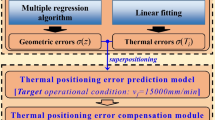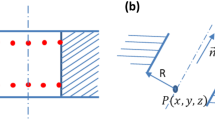Abstract
Large-size parts such as aircraft wing structures require a lot of hole machining for assembly between parts. As demand for hole positional accuracy, such as in determinant assembly (DA) concept, securing the positional accuracy of hole machining is becoming more important. Specifically, during the hole machining of large-size parts, significant errors occur due to thermal expansion according to temperature change of a machine tool and a workpiece. In this study, a technique for efficiently reducing the positional error of hole machining in large-size parts is proposed by compensating geometric errors and thermal errors of a machine tool and a workpiece. The thermal displacement error, representing changes in volume error due to temperature variations in the machine tool, is estimated by measuring the distance between the centers of two spheres on the master with low thermal expansion coefficient measured at the reference temperature (20 °C). The thermal expansion error, caused by variations in workpiece temperature, is estimated by assuming the temperature of the workpiece to be that of the cutting fluid just before machining. Hole machining errors are integrally compensated by considering the geometric error measured at the reference temperature and the thermal errors of the machine tool and the workpiece. In the verification experiment, the maximum error was improved by 60.2%, and it was confirmed that the tendency of the error was significantly reduced.















Similar content being viewed by others
References
du Plessis, A., & Rossouw, P. (2015). X-ray computed tomography of a titanium aerospace investment casting. Case Studies in Nondestructive Testing and Evaluation, 3, 21–26. https://doi.org/10.1016/j.csndt.2015.03.001
Muelaner, J. E., Kayani, A., Martin, O., & Maropoulos, P. (2011, September). Measurement assisted assembly and the roadmap to part-to-part assembly. In 7th international conference on digital enterprise technology (pp. 11–19). Bath: University of Bath.
Muelaner, J. E., Martin, O. C., & Maropoulos, P. G. (2013). Achieving low cost and high quality aero structure assembly through integrated digital metrology systems. Procedia CIRP, 7, 688–693. https://doi.org/10.1016/j.procir.2013.06.054
Hartmann, J., Meeker, C., Weller, M., Izzard, N., Smith, A., Ferguson, A., & Ellson, A. (2004). Determinate assembly of tooling allows concurrent design of Airbus wings and major assembly fixtures (No. 2004-01-2832).
Burley, G., Odi, R., Naing, S., Williamson, A., & Corbett, J. (1999). Jigless aerospace manufacture-The enabling technologies (No. 1999-01-2286). SAE Technical Paper. https://doi.org/10.4271/1999-01-2286
Bullen, G. N. (1997). The mechanization/automation of major aircraft assembly tools. Production and Inventory Management Journal, 38(3), 84.
Williams, G., Chalupa, E., Billieu, R., Murphy, J., & Swager, D. (1998). Gaugeless tooling. SAE Transactions, 1998, 1241–1246.
Liu, X., An, L., Wang, Z., Tan, C., Wang, X., & Yu, S. (2019). Assembly variation analysis of aircraft panels under part-to-part locating scheme. International Journal of Aerospace Engineering. https://doi.org/10.1155/2019/9563596
Mayr, J., Jedrzejewski, J., Uhlmann, E., Donmez, M. A., Knapp, W., Härtig, F., & Wegener, K. (2012). Thermal issues in machine tools. CIRP Annals, 61(2), 771–791. https://doi.org/10.1016/j.cirp.2012.05.008
Kang, G. S., Kim, J. H., Choi, Y. J., & Lee, D. Y. (2022). In-process identification of the cutting force coefficients in milling based on a virtual machining model. International Journal of Precision Engineering and Manufacturing, 23(8), 839–851.
Lee, J. C., Lee, H. H., & Yang, S. H. (2016). Total measurement of geometric errors of a three-axis machine tool by developing a hybrid technique. International Journal of Precision Engineering and Manufacturing, 17(4), 427–432.
Yang, S. H., Lee, H. H., & Lee, K. I. (2018). Face-and body-diagonal length tests using a double ball-bar for squareness errors of machine tools. International Journal of Precision Engineering and Manufacturing, 19, 1039–1045. https://doi.org/10.1007/s12541-018-0123-y
Li, J., Mei, B., Shuai, C., Liu, X. J., & Liu, D. (2019). A volumetric positioning error compensation method for five-axis machine tools. The International Journal of Advanced Manufacturing Technology, 103, 3979–3989. https://doi.org/10.1007/s00170-019-03745-8
Bryan, J. (1990). International status of thermal error research (1990). CIRP annals, 39(2), 645–656. https://doi.org/10.1016/S0007-8506(07)63001-7
Yang, M., & Lee, J. (1998). Measurement and prediction of thermal errors of a CNC machining center using two spherical balls. Journal of Materials Processing Technology, 75(1–3), 180–189. https://doi.org/10.1016/S0924-0136(97)00316-6
Yang, S., Yuan, J., & Ni, J. (1996). The improvement of thermal error modeling and compensating on machine tools by CMAC neural network. International Journal of Machine Tools and Manufacturing, 36(4), 527–537. https://doi.org/10.1016/0890-6955(95)00040-2
Mori, K., Kono, D., & Matsubara, A. (2021). Effect of expansion coefficient difference between machine tool and workpiece to the thermal deformation induced by room temperature change. Procedia CIRP, 101, 318–321. https://doi.org/10.1016/j.procir.2021.02.034
Lee, D., Zhu, Z., Lee, K., & Yang, S. (2011). Identification and measurement of geometric errors for a five-axis machine tool with a tilting head using a double ball-bar. International Journal of Precision Engineering and Manufacturing, 12(2), 337–343. https://doi.org/10.1007/s12541-011-0044-5
Chen, C., Yuan, J., & Ni, J. (2001). A displacement measurement approach for machine geometric error assessment. International Journal of Machine Tools & Manufacture, 41(1), 149–161. https://doi.org/10.1016/S0890-6955(00)00049-3
Lee, H., Lee, D., & Yang, S. (2014). A technique for accuracy improvement of squareness estimation using a double ball-bar. Measurement Science and Technology, 25(9), 094009. https://doi.org/10.1088/0957-0233/25/9/094009
ASTM E228-11. (2016). Standard test method for linear thermal expansion of solid materials with a push-rod dilatometer. ASTM International. https://doi.org/10.1520/E0228-11
Acknowledgements
This work was supported by the Korea Institute of Industrial Technology (KITECH) as "Autonomous Manufacturing Technology based on DNA Platform (kitch EH-24-0002)" and "Development of an on-site facility attached cryogenic machining integrated system (kitech EH-23-0011)".
Author information
Authors and Affiliations
Corresponding author
Additional information
Publisher's Note
Springer Nature remains neutral with regard to jurisdictional claims in published maps and institutional affiliations.
Rights and permissions
Springer Nature or its licensor (e.g. a society or other partner) holds exclusive rights to this article under a publishing agreement with the author(s) or other rightsholder(s); author self-archiving of the accepted manuscript version of this article is solely governed by the terms of such publishing agreement and applicable law.
About this article
Cite this article
Gu, GW., Park, MS., Suh, JH. et al. A Technique for Integrated Compensation of Geometric Errors and Thermal Errors to Improve Positional Accuracy of Hole Machining in Large-Size Parts. Int. J. Precis. Eng. Manuf. (2024). https://doi.org/10.1007/s12541-024-01011-w
Received:
Revised:
Accepted:
Published:
DOI: https://doi.org/10.1007/s12541-024-01011-w




